How Did Empires Continue to Prove
Please make sure these dispatches reach as many readers as possible. Share with kin, friends and workmates and ask them to do likewise.
The story of earlier imperial civilizations holds cautionary lessons about our own trajectory and hidebound arrogance. In antiquity (and this is disputed) only the Roman empire seems to have reached half a millennium. In modern times, despite their global footprint and technological prowess, no European empire has survived in full dominance beyond 250 years, and even the almighty US empire is showing signs of dysfunction and collapse in less than 150. Imperial trajectories are normally marked by lucky serendipity, accomplishments, narcissism, hubris, overreach, internal decay, and plenty of savage criminality—in the open or disguised, as is the favorite mode in our so-called democracies. Eventually, the rot within proves to be the decisive morbidity. In this post, we take a look at the Assyrian empire. We offer three views. What do you think?
CLICK ON IMAGES FOR BEST APPRECIATION
Appearing in The Guardian,
'Some of the most appalling images ever created' – I Am Ashurbanipal review
By Jonathan Jones

'They fought lions, to prove their superhuman virility' … Ashurbanipal in combat. Photograph: The British Museum/PA
British Museum, London
Whether wrestling lions or skinning prisoners alive, the Assyrian king ran a murderously efficient empire. This is the art of war – and it's terrifying
Assyrians: Cavalry and Conquests
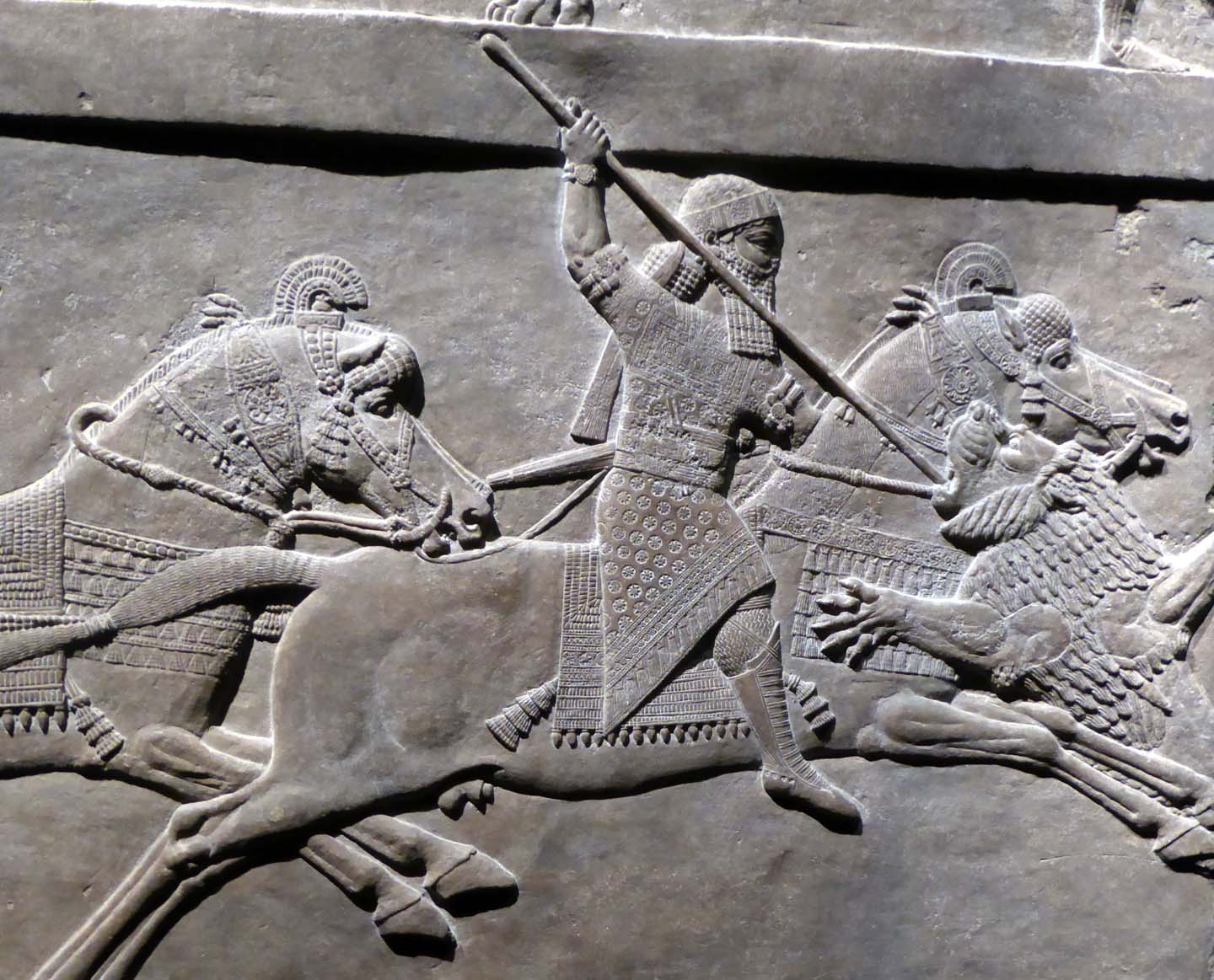
Although Assyrian is like most Middle Eastern languages, part of the Semitic language family, the Assyrian people are ethnically distinct from other members of this Semitic group.
Much of Assyria's history is closely tied to its southern neighbor, Babylonia. The two Mesopotamian empires spoke similar languages and worshipped most of the same gods. They were often rivals on the battlefield for influence in the ancient Middle East.
The history of Assyria spans mainly from about 2000 B.C.E , when the cities of Nineveh and Calah were founded, to the destruction of Nineveh in 606 B.C.E.
Whereas Babylonia is best remembered for its contributions in literature, architecture, and the law, Assyria is chiefly remembered for its military prowess, advances in weaponry, and meticulously recorded conquests.
Geographically, Assyria occupied the middle and northern part of Mesopotamia. It was situated between the Euphrates and Tigris Rivers, and its major cities were Calah, Zab, Ashur, and the capital, Nineveh.
The Power and the Gory
 "I am powerful, I am all-powerful .... I am without equal among all kings."
"I am powerful, I am all-powerful .... I am without equal among all kings."
This was the boast of King Esarhaddon (680-669 B.C.E.), who expanded the Assyrian empire to its greatest extent. At the height of his great power, in 671 B.C.E., he conquered Egypt in less than a month.
The Egyptian kingdom was considered one of the most impenetrable in the Middle East. The Egyptians had ruled over their own land virtually undisturbed for 2,500 years.
Once Egypt was captured, Esarhaddon and his successor, Assurbanipal (680-626 B.C.E.), ruled an empire that stretched over 1,000 miles from the Nile River to the Caucasus Mountains. In its time, the Assyrian Empire was the greatest the world had ever seen. The center of the empire was located in what is now northern Iraq, and its capital was called Nineveh.
Tiglath-pileser I
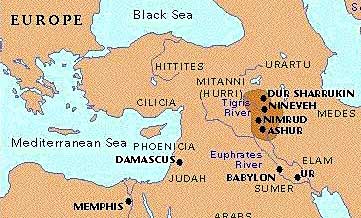
Few could stand in the way of the Assyrian expansion. After toppling the Babylonian Empire, the Assyrians conquered the Israelites, the Phoenicians, and even parts of the mighty Egyptian Empire.
Tiglath-pileser I was an early Assyrian king who began his reign in about 1100 B.C.E. He mounted several successful military campaigns against the Babylonians, Syrians, and many others.
He claims to have conquered 42 kings and peoples and wrote, "I carried away their possessions, burned their cities with fire, demanded from their hostages tribute and contributions, and laid on them the heavy yoke of my rule."
The Assyrian ruler also claimed great expertise as a hunter who on one expedition killed over 900 lions and captured several elephants alive.
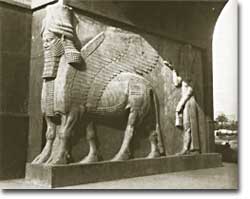
This guardian (notice the 5th leg) protected an Assyrian citadel gate in Khorsabad.
In the city of Asshur he kept a hunting park in which to prey on animals. At Nineveh, he started a botanical garden in which he planted trees and fauna gathered during his military campaigns.
How did the Assyrians establish such a large empire over such formidable foes? Their armies were highly trained and professional. And their troops had a great deal of experience in battle. They were well organized into various units of charioteers, cavalry, bowmen, and lancers.
Assyrian armies also had a corps of engineers who employed movable towers and iron-headed battering rams for sieges on walled towns.
Soldiers used iron weapons, which were much stronger than the bronze weapons of some of their foes. The Assyrians also built roads for the quick and easy movement of troops, so that conquered rebelling kingdoms could easily be brought back under control.
Fear was another tool used by the Assyrians. Although all wars are cruel, the Assyrians were notorious for their widespread use of torture. The words of an early Assyrian king, Assurnarsipal, reveal just how cruel the Assyrians could be:
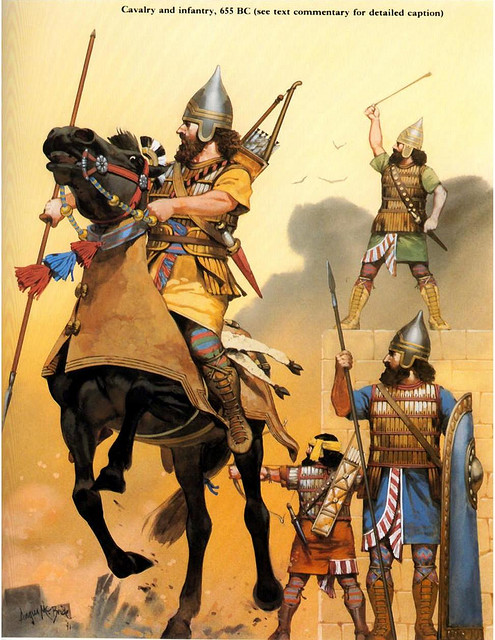

The Spoils of Victory
In ancient times, kings usually led their troops into battle and were highly skilled soldiers themselves. It was the custom of Assyrian kings to record their victories on the walls of their immense and extravagant palaces. The relief sculptures on the walls of King Assurbanipal's palace in Nineveh are some of the most elaborate. These sculptures, along with an important collection of cuneiform clay tablets — 25,000 of them — were discovered by Austen Henry Layard and his colleagues in the 1840s.
Empires meant power. This power led to extravagant wealth for the victors, who forced the conquered peoples into paying them tribute or taxes. The Assyrian kings had no end of such wealth.
Paying Tribute
The Assyrian king Sennacherib (704-681 B.C.E.) describes the tribute he exacted from the Hebrew king Hezekiah. Hezekiah withstood the Assyrians' siege in the capital city of Jerusalem in an event that is also recounted in the Bible. But the Hebrews still had to give enormous tribute and presents to the Assyrians.
Sennacherib explains in his own words on a tablet that was discovered by archaeologists: "He sent [a convoy] after me to Nineveh, my royal city with 30 talents of gold, 800 talents of silver, jewels, antimony ... couches of ivory, easy chairs inlaid with ivory, elephants' hides, elephants' tusks ... all kinds of valuable treasures, and his daughters, his harem, and male and female singers."
More than Warriors
With the wealth they obtained from war and tribute, the Assyrian kings built the well-fortified and beautiful cities of Nineveh, Calah, (present-day Nimrud).
In these cities, they placed their grand palaces, some of which spanned several acres. It these places, Assyrian kings showed their more cultured side.
The first glassmaking, the invention of backgammon, the ancestor of the lock and key, even therapeutic massage, are thought by many scholars to be Assyrian inventions.
But the Assyrian Empire's grandeur did not last. Just as it reached its peak, it began to crumble. Fighting between King Assurbanipal and his brother weakened the empire and opening it up to foreign invaders. The Assyrian Empire was eventually destroyed in 612 B.C.E. by the Medes from the Iranian Plateau and the Chaldeans of Babylonia.
It never rose again.
And finally, we present this view, by The Conversation. The surprising argument here is that climate change had a great deal to do with the Assyrian empire's rapid collapse and disappearance.
Climate change fueled the rise and demise of the Neo-Assyrian Empire, superpower of the ancient world
A ncient Mesopotamia, the fabled land between the Tigris and the Euphrates rivers, was the command and control center of the Neo-Assyrian Empire. This ancient superpower was the largest empire of its time, lasting from 912 BC to 609 BC in what is now modern Iraq and Syria. At its height, the Assyrian state stretched from the Mediterranean and Egypt in the west to the Persian Gulf and western Iran in the east.
Then, in an astonishing reversal of fortune, the Neo-Assyrian Empire plummeted from its zenith (circa 650 BC) to complete political collapse within the span of just a few decades. What happened?
Numerous theories attempt to explain the Assyrian collapse. Most researchers attribute it to imperial overexpansion, civil wars, political unrest and Assyrian military defeat by a coalition of Babylonian and Median forces in 612 BC. But exactly how these two small armies were able to annihilate what was then the most powerful military force in the world has mystified historians and archaeologists for more than a hundred years.
Our new research published in the journal Science Advances sheds light on these mysteries. We show that climate change was the proverbial double-edged sword that first contributed to the meteoric rise of the Neo-Assyrian Empire and then to its precipitous collapse.

An artist's vision of the interior of an Assyrian palace, based on drawings made in 1849 by Austen Henry Layard on the site of 19th century excavations.New York Public library digital collections, CC BY-ND
Booming right up to an unexpected bust
The Neo-Assyrian state was an economic powerhouse. Its formidable war machine boasted a large standing army with cavalry, chariots and iron weaponry. For over two centuries, the mighty Assyrians waged relentless military campaigns with ruthless efficiency. They conquered, plundered and subjugated major regional powers across the Near and Middle East, as each Assyrian king tried to outshine his predecessor.
Ashurbanipal, the last great king of Assyria, ruled this vast empire from the ancient city of Nineveh, the ruins of which lie across the Tigris River from modern Mosul, Iraq. Nineveh was a sprawling metropolis of unprecedented size and grandeur filled with temples and palace complexes, with exotic gardens that were watered by an extensive system of canals and aqueducts.
And then it all ended within just a few years. Why?
Our research group wanted to investigate climate conditions over the few centuries when the Neo-Assyrian Empire took hold and then eventually collapsed.
Building a picture of climate 2,600 years ago
For clues about rainfall patterns over northern Mesopotamia, we turned to Kuna Ba cave, located near Nineveh.
Our colleagues collected samples from the cave's stalagmites. These are the cone-like structures that point upward from the cave floor. They grow slowly, from the ground up, as rainwater drips down from the cave ceiling, depositing dissolved minerals.
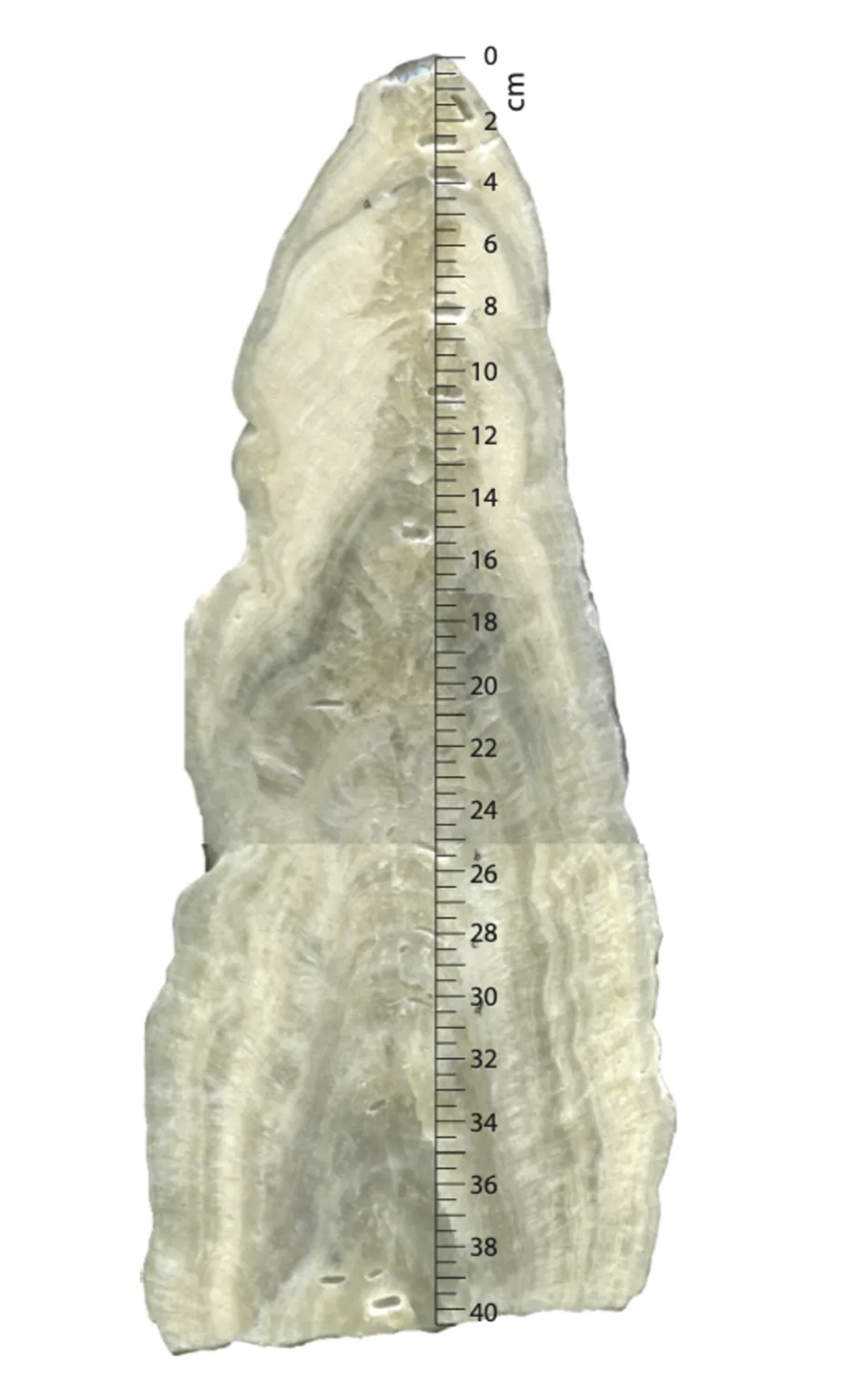
The layers of a stalagmite record the climate conditions of the time when they were created. (Ashish Sinha, CC BY-ND)
The rainwater naturally contains heavy and light isotopes of oxygen – that is, atoms of oxygen that have different numbers of neutrons. Subtle variations in the oxygen isotope ratios can be sensitive indicators of climatic conditions at the time the rainwater originally fell. As stalagmites grow, they lock into their structure the oxygen isotope ratios of the percolating rainwater that seeps into the cave.
We painstakingly pieced together the climatic history of northern Mesopotamia by carefully drilling into stalagmites, across their growth rings, which are similar to those of trees. In each sample, we measured the oxygen isotope ratios to build a timeline of how conditions changed. That told us the order of events but didn't tell us the amount of time that elapsed between them.
Luckily, the stalagmites also trap uranium, an element that's ever-present in trace amounts in the infiltrating water. Over time, uranium decays into thorium at a predictable pace. So the dating experts on our research team made scores of high-precision uranium-thorium measurements on stalagmite growth layers.
Together these two kinds of measurements let us anchor our climate record to precise calendar years.
Unusual wet period, then massive drought
Now a direct comparison of the stalagmite climate record with the historical and archaeological records from the region was possible. We wanted to place the key events of Neo-Assyrian history into the long-term context of our climate reconstruction.
We found that the most significant expansion phase of the Neo-Assyrian state occurred during a two-centuries-long interval of anomalously wet climate, as compared with the previous 4,000 years. Called a megapluvial period, this time of unusually high rainfall was immediately followed by megadroughts during the early-to-mid-seventh century BC. These ancient dry conditions were as severe as recent droughts in Iraq and Syria but lasted for decades. The period marking the collapse of the Neo-Assyrian Empire occurred well within this time frame.

The Neo-Assyrian Empire rose during an unusual time of wet climate and collapsed soon after conditions swung to unusual dryness. Ashish Sinha, CC BY-ND
Mindful of the caveat that correlation doesn't imply causation, we were interested in how this wild climate swing – an unusually rainy period that ended in drought – could have influenced an empire.
While the Neo-Assyrian state was huge in its final few decades, its economic core was always confined to a rather small region. This relatively small area in northern Mesopotamia served as a primary source of agricultural revenues and powered Assyrian military campaigns.
We argue that nearly two centuries of unusually wet conditions in this otherwise semi-arid region allowed for agriculture to flourish and energized the Assyrian economy. The climate acted as a catalyst for the creation of a dense network of urban and rural settlements in the unsettled zones that previously hadn't been able to support farming.
Our data show the wet period abruptly ended and the pendulum swung the other way. In the grips of recurring megadroughts, the Assyrian core and its hinterlands would have been engulfed within a "zone of uncertainty" – a corridor of land where the rainfall is highly erratic and any rain-fed agriculture comes with a large risk of crop failure.
Repeated crop failures likely exacerbated the political unrest in Assyria, crippled its economy and empowered the adjacent rival states.
Uncertain climate, unsustainable growth
Our findings have current-day implications.
In modern times, the same region that once constituted the Assyrian core has been repeatedly struck by multiyear droughts. The catastrophic drought of 2007–2008 in northern Iraq and Syria, the most severe in the past 50 years, led to cereal crop failures across the region.
Droughts like this one offer a glimpse of what Assyrians endured during the mid-seventh century BC. And the collapse of the Neo-Assyrian Empire offers a warning to today's societies.
Climate change is here to stay. In the 21st century, people have what Neo-Assyrians did not: the benefit of hindsight and plenty of observational data. Unsustainable growth in politically volatile and water-stressed regions is a time-tested recipe for disaster.
[ You're too busy to read everything. We get it. That's why we've got a weekly newsletter. Sign up for good Sunday reading. ]
Source: https://www.greanvillepost.com/2021/01/22/the-assyrians-rise-and-fall-of-a-brutal-empire/

0 Response to "How Did Empires Continue to Prove"
Publicar un comentario